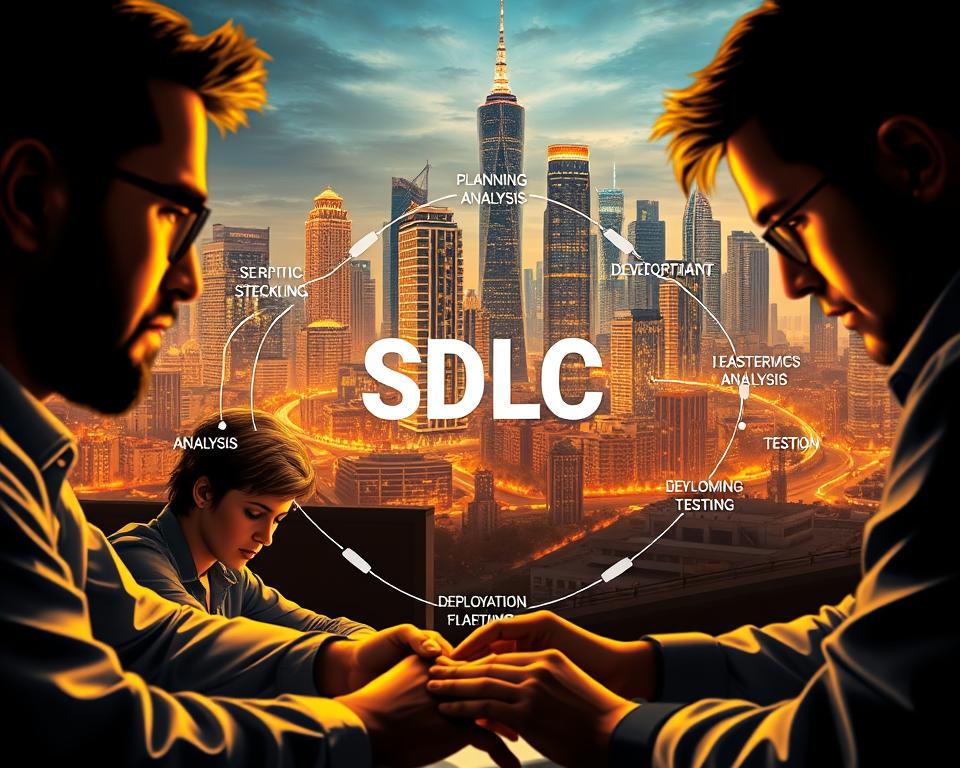
Tech in the USA: Innovations and Insights
Did you know that the United States accounts for over 30% of the global technology market? This striking statistic highlights the immense influence and innovation emanating from the American tech landscape. As we venture into the dynamic world of technology in the USA, it becomes evident just how vital these advancements are across various sectors, including healthcare, finance, and education. From the renowned Silicon Valley to a burgeoning array of tech startups throughout the country, the rapid evolution of digital innovation is reshaping every aspect of American society. In this section, we will explore the transformative role of tech in the USA, showcasing how these innovations not only drive economic growth but also enhance our everyday lives.

Key Takeaways
- The USA holds more than 30% of the global tech market.
- Silicon Valley remains a central hub for technological advancements.
- Emerging technologies positively impact various sectors, such as healthcare and finance.
- Tech startups across the nation contribute significantly to digital innovation.
- Innovations in tech drive economic growth in the United States.
Introduction to Tech Innovations in the USA
The USA stands at the forefront of technology advancements, shaping an innovation landscape that influences markets and consumer behavior globally. From cutting-edge software solutions to revolutionary consumer electronics, these developments transform industries and redefine standards of productivity and connectivity.
Digital trends play a fundamental role in this evolution, driving businesses to integrate technology seamlessly into their operations. Companies leverage advanced analytics, cloud computing, and artificial intelligence to enhance efficiency and respond to changing consumer demands. Startups and established enterprises alike adapt to these shifts, leading to a dynamic market environment.
The impact of these innovations extends beyond technical enhancements. Organizations must embrace a holistic approach to digital transformation, aligning their business strategies with these advancements. This change fosters an interconnected ecosystem where emerging technologies pave the way for improved customer experiences and operational efficiencies.
| Technology Advancement | Key Impact | Industry Transformation |
|---|---|---|
| Cloud Computing | Scalability and Cost Efficiency | IT and Business Services |
| Artificial Intelligence | Enhanced Decision Making | Healthcare and Retail |
| IoT Devices | Data Collection and Monitoring | Manufacturing and Agriculture |
| Blockchain | Increased Transparency | Finance and Supply Chain |
In navigating this ever-evolving innovation landscape, businesses in the USA prioritize adaptability and foresight. The continuous drive for technology advancements ensures they remain competitive and responsive to emerging trends, ultimately fostering a culture of innovation across multiple sectors.
The Rise of Silicon Valley as a Global Tech Hub
Silicon Valley has established itself as the leading global tech hub, becoming synonymous with groundbreaking innovation and entrepreneurial ventures. Home to industry titans like Google, Facebook, and Apple, the region has transformed various sectors through technological advancements.
A key element in Silicon Valley’s success stems from a robust innovation ecosystem. This vibrant community attracts an impressive number of tech startups that thrive on collaboration, sharing ideas and resources. The atmosphere encourages creativity and experimentation, empowering entrepreneurs to take risks and develop revolutionary products.
Venture capital investment plays a significant role in fueling this dynamic environment. Investors flock to Silicon Valley seeking to finance the next big idea. This financial backing not only supports early-stage companies but also nurtures their growth into significant players in the tech landscape.
In addition, talent acquisition remains a crucial factor behind Silicon Valley’s dominance. The region draws top graduates from prestigious universities, equipping startups with skilled individuals eager to innovate and contribute. This blend of talent and investment fortifies Silicon Valley’s reputation as a premier destination for tech ventures.

The unique combination of collaboration, funding, and talent creates an unparalleled environment for tech startups, establishing Silicon Valley as a model for successful innovation worldwide.
The Role of Emerging Technologies in the USA
Emerging technologies have increasingly become a driving force behind innovation in the United States. These advancements shape various industries, enhancing efficiency and paving the way for new solutions. Among these technologies, artificial intelligence (AI) and machine learning have emerged as pivotal components in transforming how businesses operate.
Artificial Intelligence and Machine Learning
AI innovations, particularly in machine learning trends, have redefined customer interactions and operational efficiencies across sectors. Companies like IBM and Amazon utilize these technologies to analyze vast quantities of data, driving insights that support informed decision-making. For instance, AI-powered chatbots are widely employed in customer service, providing immediate assistance and reducing wait times, which improves user satisfaction.
Furthermore, in manufacturing, machine learning algorithms streamline production processes by predicting maintenance needs and optimizing supply chains. This ability to leverage data analysis not only fosters innovation but also enhances competitiveness in the global market.
Blockchain and Cryptocurrency Innovations
Blockchain technology represents another significant territory within emerging technologies. While primarily known for powering cryptocurrencies like Bitcoin, its applications in data security, transparency, and transaction efficiency have gained traction among various industries. Companies in finance, logistics, and healthcare are increasingly exploring blockchain’s potential to improve trust and minimize fraud in their operations.
As these technologies continue to evolve, their integration into various sectors signifies the growing importance of AI and blockchain as tools for progress in the United States. Organizations that embrace these innovations stand to gain substantial advantages in this rapidly changing digital landscape.
Tech Advancements in Healthcare
The landscape of healthcare has evolved significantly, driven by telemedicine growth and digital health trends that have reshaped patient care technology. The COVID-19 pandemic acted as a catalyst, propelling healthcare providers to adopt innovative solutions that prioritize patient accessibility and streamline service delivery. Organizations like Teladoc and Doxy.me exemplify this shift, offering virtual consultations that enhance patient engagement and reduce the costs associated with traditional healthcare settings.
Telemedicine and Digital Health Solutions
Telemedicine has emerged as a cornerstone of modern healthcare. By enabling real-time consultations, it allows patients to connect with healthcare providers from the comfort of their homes. This technology not only improves patient comfort but also mitigates travel-related hardships. As a result, many individuals gain access to necessary healthcare services that may have been previously out of reach. The telemedicine growth trend reflects a broader acceptance of virtual care models among patients and providers alike.
The Impact of Wearable Technology
Wearable technology has become an integral part of the patient care technology landscape. Devices such as smartwatches and fitness trackers facilitate continuous health monitoring, providing valuable data to both patients and healthcare professionals. By harnessing this information, providers can tailor personalized care strategies that proactively address health concerns. The synergy between telemedicine and wearables enhances the overall healthcare experience, illustrating the dynamic interplay between technology and patient care.
Software Development Trends in the USA
The landscape of software development in the USA is evolving rapidly, particularly with the adoption of agile methodologies and DevOps practices. Companies are becoming increasingly aware of the need for efficiency in coding as they strive for faster and high-quality releases. This shift enables tech teams to adapt swiftly to changing market demands, fundamentally altering the way software is created and managed.
Agile Methodologies and DevOps Practices
Agile software development emphasizes flexibility and collaboration among team members. By breaking projects into manageable units of work, teams can iterate quickly, ensuring that they meet user needs effectively. The integration of DevOps trends supports this dynamic environment by fostering closer collaboration between development and operations. This convergence enhances the deployment process and leads to a more seamless transition from development to production.
Open Source and Collaborative Development
The rise of open-source projects has significantly influenced the software development sector. These initiatives promote collaboration among developers around the globe, enhancing the efficiency in coding. Organizations can leverage these shared resources to innovate more rapidly while benefiting from diverse perspectives and skills.
| Trend | Description | Benefits |
|---|---|---|
| Agile Methodologies | Iterative development with a focus on collaboration and customer feedback. | Faster delivery, improved product quality, and enhanced responsiveness. |
| DevOps Practices | Integration of development and IT operations to improve collaboration. | Faster deployments, reduced failure rates, and quicker recovery. |
| Open Source Development | Collaborative projects that invite contributions from multiple developers. | Access to a wealth of resources and diverse solutions. |
Tech in USA: Contributing to Economic Growth
The technology sector plays a pivotal role in shaping the economy of the United States, primarily through its significant economic impact. As digital advancements proliferate, companies heavily invest in tech job creation, leading to millions of new positions across various sectors. Statistics reflect consistent growth trends, with a surge in demand for skilled professionals in tech, software development, and data analytics.
Moreover, the ripple effects on supporting industries cannot be overlooked. As tech companies expand their workforce, they foster innovation-driven growth, benefiting adjacent markets such as real estate, transportation, and education. This dynamic interconnection serves to amplify overall productivity, enhancing the economic landscape.
For instance, a recent report highlighted that tech jobs are projected to grow by 22% over the next decade, much faster than the average for all other occupations. This trend not only showcases the potential for economic impact but also illustrates the critical nature of technology in driving the future of work.
Renewable Energy Technology Innovations
Advancements in renewable energy tech play a crucial role in transforming America’s energy landscape. With a growing emphasis on sustainability, both solar innovations and wind energy trends are witnessing significant developments that aim to reduce carbon footprints and promote cleaner energy usage. Leading companies are continually pushing boundaries to enhance efficiency and reduce costs, allowing renewable energy sources to become more accessible and effective.
Solar and Wind Energy Solutions
Solar power has seen remarkable enhancements through the development of more efficient photovoltaic panels. Companies like Tesla leverage cutting-edge technology to improve performance and affordability in solar energy systems. Wind energy trends reflect similar progress, showcasing larger and more efficient turbines that harness wind with greater efficacy. These advances facilitate greater energy production while promoting cleaner alternatives to fossil fuels.
Smart Grid Technologies
The conception of smart grid technologies is vital in optimizing energy distribution and consumption. These systems integrate renewable energy inputs seamlessly, allowing for real-time communication between energy producers and consumers. As smart grids enhance grid reliability, they also reduce energy waste and encourage the adoption of solar innovations and wind energy solutions across various regions. Effective collaboration among energy providers and tech companies accelerates this transition, creating more energizing possibilities for the future.
The American Tech Ecosystem: Key Players
The landscape of the American tech ecosystem thrives on the collaboration and competition among leading tech companies and innovative startups. This dynamic environment fosters startup innovations that challenge established norms and explore new frontiers. Companies like Amazon and Google stand out as top tech companies, driving significant advancements while nurturing smaller enterprises that contribute to a rich competitive landscape.
Leading Tech Companies and Startups
Top tech companies serve as anchors in the American tech ecosystem. Notable giants such as Microsoft and Apple showcase how innovation can redefine technology. In parallel, a plethora of startups emerges, tackling diverse challenges and introducing groundbreaking solutions.
- Amazon: Pioneering e-commerce and cloud computing.
- Google: Leading in search technology and artificial intelligence.
- SpaceX: Innovating aerospace with reusable rocket technology.
- Slack: Transforming workplace communication through collaboration tools.
- Zoom: Redefining virtual interaction in a connected world.
These companies, among others, contribute to an enriching competitive landscape where emerging ideas find a platform. Startups play a vital role, often funded through venture capital, cultivating new technologies and business models that disrupt traditional markets.
Government Initiatives Supporting Tech Growth
To further enhance the tech ecosystem, government initiatives focus on promoting research and development. Programs aimed at supporting digital infrastructure, workforce training, and tax incentives for innovation foster a nurturing environment for both established and fledgling firms.
- The Small Business Innovation Research (SBIR) program enhances startup opportunities.
- Investment in tech education prepares the future workforce.
- Grants for research projects bolster innovation at universities.
Such initiatives underscore the importance of a collaborative approach, reflecting the adaptability and resilience of America’s tech community in a rapidly evolving global market.
Trends in Digital Innovation and Tech Adoption
Recent advancements highlight significant digital transformation trends shaping the landscape of tech in business. Companies increasingly embrace cloud computing, as it offers scalable solutions to accommodate rising demands for flexibility and efficiency. Organizations recognize the growing importance of e-commerce platforms, enabling seamless consumer experiences across various digital channels.
Consumer tech adoption is on the rise, with mobile applications leading the charge. Users prioritize convenience and instant access to services, influencing businesses to integrate innovative technologies into their operations. The shift towards mobile-friendly solutions aids companies in reaching broader audiences while streamlining customer interactions.
The following table captures some key trends in digital innovation and their impact on consumer tech adoption:
| Trend | Impact on Tech in Business | Examples |
|---|---|---|
| Cloud Computing | Enhances scalability and flexibility | Amazon Web Services, Microsoft Azure |
| E-commerce Growth | Increases market reach and sales channels | Shopify, BigCommerce |
| Mobile Applications | Improves consumer access and engagement | DoorDash, Uber Eats |
The Future of Remote Work and Digital Services
The COVID-19 pandemic has reshaped traditional work environments, leading to significant remote work trends across various industries. Companies are now more inclined to embrace flexible work policies, allowing employees to work from locations that suit their needs. This shift showcases the evolving nature of the workforce technology utilized by businesses, as they invest in tools that facilitate effective remote collaboration.
This digital services evolution shows no signs of slowing. Organizations are adopting advanced technologies that promote connectivity and productivity, enabling teams to collaborate seamlessly, regardless of their physical location. From video conferencing platforms to collaborative project management software, these tools are becoming the backbone of modern remote workflows.
Moreover, the emphasis on digital literacy among employees has become increasingly vital. As companies navigate the complexities of a remote work environment, ensuring that staff members possess the skills needed to effectively utilize these new tools is essential. Investing in training programs and resources will not only enhance individual performance but also strengthen overall organizational resilience.
As organizations continue to adapt to the changing landscape, the integration of effective workforce technology will be instrumental in shaping the future of work. The lessons learned during the pandemic will pave the way for new strategies that prioritize flexibility, collaboration, and technological proficiency.
Challenges Facing the USA Tech Industry
The landscape of the USA tech industry is dynamic, marked by significant advancements and equally pressing challenges. Among these, cybersecurity threats pose some of the most critical risks. Businesses of all sizes must address the rising incidents of data breaches and hacking attempts, which threaten not only their operations but also the trust of their customers. Understanding these cybersecurity challenges is essential for developing effective strategies.
Cybersecurity Threats and Solutions
The frequency and sophistication of cyber attacks have increased, making it important for organizations to implement robust tech security solutions. To tackle these challenges, companies often rely on technologies such as:
- Advanced encryption to shield sensitive information.
- Multi-factor authentication to add an extra layer of security.
- Intrusion detection systems that identify and react to breaches in real time.
These measures not only help in protecting data but also reassure clients that their information will remain secure. Companies should adopt a proactive approach that includes regular updates to security protocols and employee training to recognize phishing threats.
Regulatory and Compliance Issues
Navigating the complex landscape of regulatory requirements presents another challenge. Organizations face strict guidelines aimed at protecting data, which vary across industries and states. Ensuring compliance requires the following:
- Continuous monitoring of regulatory changes to stay informed.
- Implementing compliant data handling and storage practices.
- Conducting regular audits to evaluate adherence to regulations.
Ultimately, overcoming these regulatory hurdles is crucial for protecting data and fostering a secure environment for tech innovation. As the industry evolves, so too must the strategies to combat cybersecurity challenges and ensure compliance.
Women and Diversity in the Tech Workforce
Diversity in tech is crucial for fostering innovation and creativity within the industry. The representation of women in technology remains a pressing challenge, as only a small percentage occupy leadership positions. Organizations and initiatives actively work to promote an inclusive workforce, aiming to empower women and underrepresented minorities in the tech sector.
Companies that prioritize diversity in their hiring practices benefit from diverse perspectives, which enhance problem-solving and drive business success. Programs such as coding bootcamps and mentorship opportunities specifically designed for women in technology have emerged as effective strategies to narrow the gender gap.
Additionally, various tech organizations actively advocate for policies that support equality and inclusion. These efforts not only create a supportive environment for women but also contribute to a stronger, more competitive tech ecosystem overall.
| Company | Initiative | Impact |
|---|---|---|
| Microsoft | Women in Tech Program | Increase in female hires by 25% |
| Code for Good | 1,000+ women trained annually | |
| Salesforce | Equal Pay Initiative | Achieved gender pay parity |
In summary, cultivating a diverse workforce in technology enhances the industry’s ability to thrive and adapt to ongoing changes. By supporting women in technology and promoting diversity in tech, the industry can ensure a more equitable future for all.
Case Studies of Successful Tech Innovations
Examining the landscape of tech innovations reveals fascinating insights into the impact of groundbreaking apps and platforms on user behavior and revenue generation. Case studies featuring successful tech platform success stories illustrate how these innovations have transformed daily activities and business dynamics. Below are examples highlighting these influential developments.
Groundbreaking Apps and Platforms
Rideshare services like Uber have redefined transportation by providing convenience and accessibility at users’ fingertips. This innovative app allowed people to find rides quickly, revolutionizing how individuals approach commuting. Similarly, social media platforms such as Instagram changed how users engage with content, enabling them to connect and share experiences globally. These tech platform success stories showcase the combined potential of technology and user-centric design.
Innovative Hardware Developments
The evolution of hardware has significantly influenced user interactions with technology. Companies like Apple have consistently delivered innovative products, such as the iPhone, which integrates software and hardware seamlessly. Such advancements have set new standards in the industry, encouraging other companies to invest in similar innovative apps and devices. These case studies reaffirm the importance of hardware developments in enhancing user experience and meeting market demands.
Conclusion
The tech industry in the USA continues to be a beacon of innovation, shaping not only the American economy but also influencing global trends. As we look to the future of tech in the USA, it’s clear that an evolving tech landscape driven by creative minds and groundbreaking solutions is critical. With advancements in fields such as artificial intelligence, renewable energy, and healthcare technologies, the nation positions itself as a leader in various sectors.
However, as we embrace these digital advancements, addressing the challenges related to cybersecurity and regulatory compliance is vital for sustaining growth. The tech industry outlook suggests that overcoming these hurdles will pave the way for unparalleled opportunities in the coming years. By fostering a culture of diversity and inclusivity, the USA can harness its full potential while ensuring that every voice contributes to the narrative of progress.
Ultimately, the journey of innovation in technology is an ongoing narrative filled with promise. The synergy of entrepreneurial spirit and commitment to addressing challenges will ensure that the USA remains at the forefront of technological progress, continuing to shape the future of tech in an ever-changing global environment.





